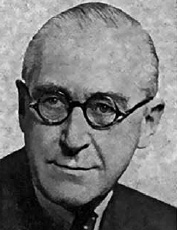Abstract
Garland and Taverner first fully described diabetic amyotrophy as a clinical entity in 1950. Its distinctive features were a painful, markedly asymmetrical proximal weakness and wasting of the thighs and legs often with diminished or absent tendon reflexes. Motor signs dominated the picture, but autonomic and sensory nerves could be involved. Characteristically it occurred in poorly controlled diabetics in whom substantial if not always complete recovery was generally observed. A lumbosacral plexus neuropathy, associated with microvasculitis with secondary inflammatory perivascular mononuclear cell infiltrates is the underlying pathology.

The inelegantly named diabetic lumbosacral radiculoplexus neuropathy (DLSRPN) was first highlighted after a clinical observation in 1950 by my erstwhile teachers, Hugh Garland (1903-1967) (Figure 1) and Deryck Taverner (1914-1998). They found only one earlier account, by Bruns in 1890 which ‘had been overlooked or dismissed as irrelevant.’ [1] The condition has similar clinical features to non-diabetic lumbosacral radiculoplexus neuropathy (LSRPN) [2.3]. Ludwig Bruns of Göttingen (1858-1916) had described three patients, aged 58, 59, and 70, suffering from diabetes mellitus of short duration; all three developed severe pain in the hip and thigh followed by weakness and wasting of leg muscles without objective sensory loss, and each recovered fairly quickly following dietary restriction [1,4]. But the condition was largely unrecognised and received no mention in neurological texts until Garland and Taverner’s report [5] of 1953, which has not been bettered:
Attention is drawn to a form of diabetic neuropathy previously described 60 years ago but forgotten. The syndrome consists of asymmetrical pain, weakness, muscle wasting, and areflexia in the legs, without objective sensory disturbance, in middle-aged patients (ages 56 to 73) with diabetes mellitus of relatively short duration. Three had unequivocal extensor plantar responses. In none was there any objective sensory disturbance. None had been treated with insulin. The protein content of the C.S.F was raised in four subjects. Electromyographic changes in the affected muscles showed denervation with decreased pattern of motor-unit activity on voluntary contraction compatible but not diagnostic of a cord lesion. Five new examples of the syndrome are described and the literature reviewed.
Garland’s subsequent paper [6] (Figure 2) in 1955 renamed the disorder diabetic amyotrophy and described subsequent progress:
In four of the original five patients, there has been a striking recovery of power, with less obvious improvement in muscle wasting, and they all demonstrate that weakness, areflexia, and extensor plantar-responses are, in this condition reversible. Since then seven additional patients have been seen… [The total of] 12 patients showing a syndrome which includes weakness and wasting of muscles with tendon areflexia, associated with frank diabetes or at least with impaired glucose tolerance. Some may result from a myelopathy. Diabetic amyotrophy is the result of uncontrolled diabetes and is probably always reversible by full diabetic control.
Comment
Diabetic amyotrophy is much less frequent than other diabetic neuropathies, affecting approximately 1% of diabetics [2]. The several designations of this syndrome point to the confusion about its pathological basis and whether the exact site of the lesion lies in the cord, spinal roots, plexus, or in the nerves. Terminology includes: diabetic myelopathy, diabetic amyotrophy, Bruns-Garland syndrome, diabetic mononeuritis multiplex, diabetic lumbosacral plexopathy, diabetic polyradiculopathy, and multifocal diabetic neuropathy [7]. Both of Garland’s papers disclose certain patients with extensor plantar responses, which led to the initial suspicion of a cord lesion despite a lack of other evidence. The term myelopathy has, however, disappeared from the title in his second report, which is couched in somewhat more cautious terms:
Because of the variable findings “amyotrophy” rather than myelopathy is perhaps the most suitable designation.
Occasional instances of upper limb involvement, and a painless form have subsequently been described [4,7], though they are mentioned in Garland’s reports. Although proximal motor signs dominate the picture, distal segments and autonomic and sensory nerves can be involved [8]. Recent studies report ischaemic injury from microvasculitis with secondary inflammatory perivascular mononuclear cell infiltrates [9] as the pathophysiological basis of typical DLSRPN. A follow-up study confirmed that improvement generally begins between three and twelve months from diagnosis, facilitated by optimal control of blood glucose levels, which can result in complete reversal of muscle wasting and weakness. Significant functional disability persists in a minority [10].
References
- Bruns L. Ueber neuritische Lahmungen beim diabetes mellitus. Berl Klin Wochenschr 1890;27:509-515. Cited by Garland.
- Dyck PJB, Norell JE, Dyck.PJ. Non-diabetic lumbosacral radiculoplexus neuropathy: Natural history, outcome and comparison with the diabetic variety. Brain 2001;124(6):1197-207. https://doi.org/10.1093/brain/124.6.1197
- Pasnoor M, Dimachkie MM, Barohn RJ. Diabetic neuropathy part 2: proximal and asymmetric phenotypes. Neurol Clin. 2013;31(2):447-62. https://doi.org/10.1016/j.ncl.2013.02.003
- Barohn RJ, Sahenk Z, Warmolts JR, Mendell JR. The Bruns-Garland syndrome (diabetic amyotrophy). Revisited 100 years later. Archives of neurology. 1991;48:1130-5. https://doi.org/10.1001/archneur.1991.00530230038018
- Garland H, Taverner D. Diabetic Myelopathy. BMJ 1953;2:405-8. https://doi.org/10.1136/bmj.1.4825.1405
- Garland H. Diabetic amyotrophy. BMJ 1955;2:1287-90. https://doi.org/10.1136/bmj.2.4951.1287
- Garces-Sanchez, Mercedes et al. “Painless diabetic motor neuropathy: a variant of diabetic lumbosacral radiculoplexus Neuropathy?” Annals of Neurology vol. 2011;69(6):1043-54. https://doi.org/10.1002/ana.22334
- Llewelyn D, Llewelyn JG. Diabetic amyotrophy: a painful radiculoplexus neuropathy Practical Neurology. Published Online First: 08 December 2018. doi: 10.1136/practneurol-2018-002105 https://doi.org/10.1136/practneurol-2018-002105
- Said G1, Lacroix C, Lozeron P, Ropert A, Planté V, Adams D. Inflammatory vasculopathy in multifocal diabetic neuropathy. Brain. 2003;126(Pt 2):376-85. https://doi.org/10.1093/brain/awg029
- Casey EB, Harrison MJG. Diabetic amyotrophy: a follow-up study. Br Med J 1972;1:656. https://doi.org/10.1136/bmj.1.5801.656